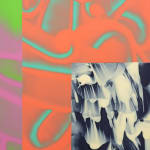David Reed
#554, 2006
Oil and alkyd on polyester
259 x 85 cm
102 x 33 1/2 inches
102 x 33 1/2 inches
Copyright the artist | Courtesy of Häusler Contemporary Zurich
Photo: Dirk Tacke
Weitere Abbildungen
In den Gemälden #335, #554 und #732-2 setzt sich David Reed mit der Beziehung zwischen Zeitlichkeit, Bewegung und Wahrnehmung auseinander, indem er dynamische Pinselstriche und Farbschichten nutzt, die wieder abgetragen...
In den Gemälden #335, #554 und #732-2 setzt sich David Reed mit der Beziehung zwischen Zeitlichkeit, Bewegung und Wahrnehmung auseinander, indem er dynamische Pinselstriche und Farbschichten nutzt, die wieder abgetragen werden. Wobei die Farben im Hintergrund die Erscheinung der Vordergrundflächen verändern. Diese Wechselwirkungen erzeugen eine Tiefe und Strahlkraft, die das Gefühl vermittelt, als käme wie bei einem Bildschirm das Licht von hinten. Diese Farbkompositionen sind stark von filmischen Ästhetiken und Bewegungen beeinflusst. Reeds Malerei verbindet somit die malerische Geste mit der Erfahrung neuer Medien, die für ihn die Art und Weise, wie wir Malerei betrachten und mit ihr interagieren stark beeinflussen. Er sieht seine Werke selbst als „media experience“, die eine ungekannte Weise der Interaktion mit Malerei ermöglichen: “I’d like painting to be part of the world and not separated from the world […] There’s a lot of new colors in the world now that we see on screens and movies and dyes and plastics, and these colors don’t yet have emotional connotations. And painting has a wonderful history of giving emotional connotations to certain colors.” Diese Verbindung zwischen traditioneller Malerei und modernen Technologien hinterfragt die emotionalen Konnotationen von Farben und bietet einen Zugang zur Malerei, die nicht nur selbstreferenziell ist, sondern mit dem Erlebten verknüpft ist. In Reeds Arbeiten eröffnen sich dadurch zahlreiche neue Bedeutungs- und Wahrnehmungsebenen, die über die Oberfläche der Leinwand hinausgehen.
In paintings #335, #554 and #732-2, David Reed explores the relationship between temporality, movement, and perception by using dynamic brushstrokes and layers of color that are subsequently removed. The background colors alter the appearance of the foreground surfaces, creating an interplay that produces a depth and radiance, giving the impression that, like a screen, light is emanating from behind. These color compositions are heavily influenced by cinematic aesthetics and movements. Reed’s painting thus bridges painterly gesture with the experience of new media, which, for him, significantly shapes the way we view and interact with painting. He describes his works as a “media experience” that enables an unprecedented interaction with painting: “I’d like painting to be part of the world and not separated from the world […] There’s a lot of new colors in the world now that we see on screens and movies and dyes and plastics, and these colors don’t yet have emotional connotations. And painting has a wonderful history of giving emotional connotations to certain colors.” This connection between traditional painting and modern technologies questions the emotional connotations of colors and offers an approach to painting that is not merely self-referential but connected to lived experience. In Reed’s works, numerous new levels of meaning and perception open up that extend beyond the canvas surface.
In paintings #335, #554 and #732-2, David Reed explores the relationship between temporality, movement, and perception by using dynamic brushstrokes and layers of color that are subsequently removed. The background colors alter the appearance of the foreground surfaces, creating an interplay that produces a depth and radiance, giving the impression that, like a screen, light is emanating from behind. These color compositions are heavily influenced by cinematic aesthetics and movements. Reed’s painting thus bridges painterly gesture with the experience of new media, which, for him, significantly shapes the way we view and interact with painting. He describes his works as a “media experience” that enables an unprecedented interaction with painting: “I’d like painting to be part of the world and not separated from the world […] There’s a lot of new colors in the world now that we see on screens and movies and dyes and plastics, and these colors don’t yet have emotional connotations. And painting has a wonderful history of giving emotional connotations to certain colors.” This connection between traditional painting and modern technologies questions the emotional connotations of colors and offers an approach to painting that is not merely self-referential but connected to lived experience. In Reed’s works, numerous new levels of meaning and perception open up that extend beyond the canvas surface.









